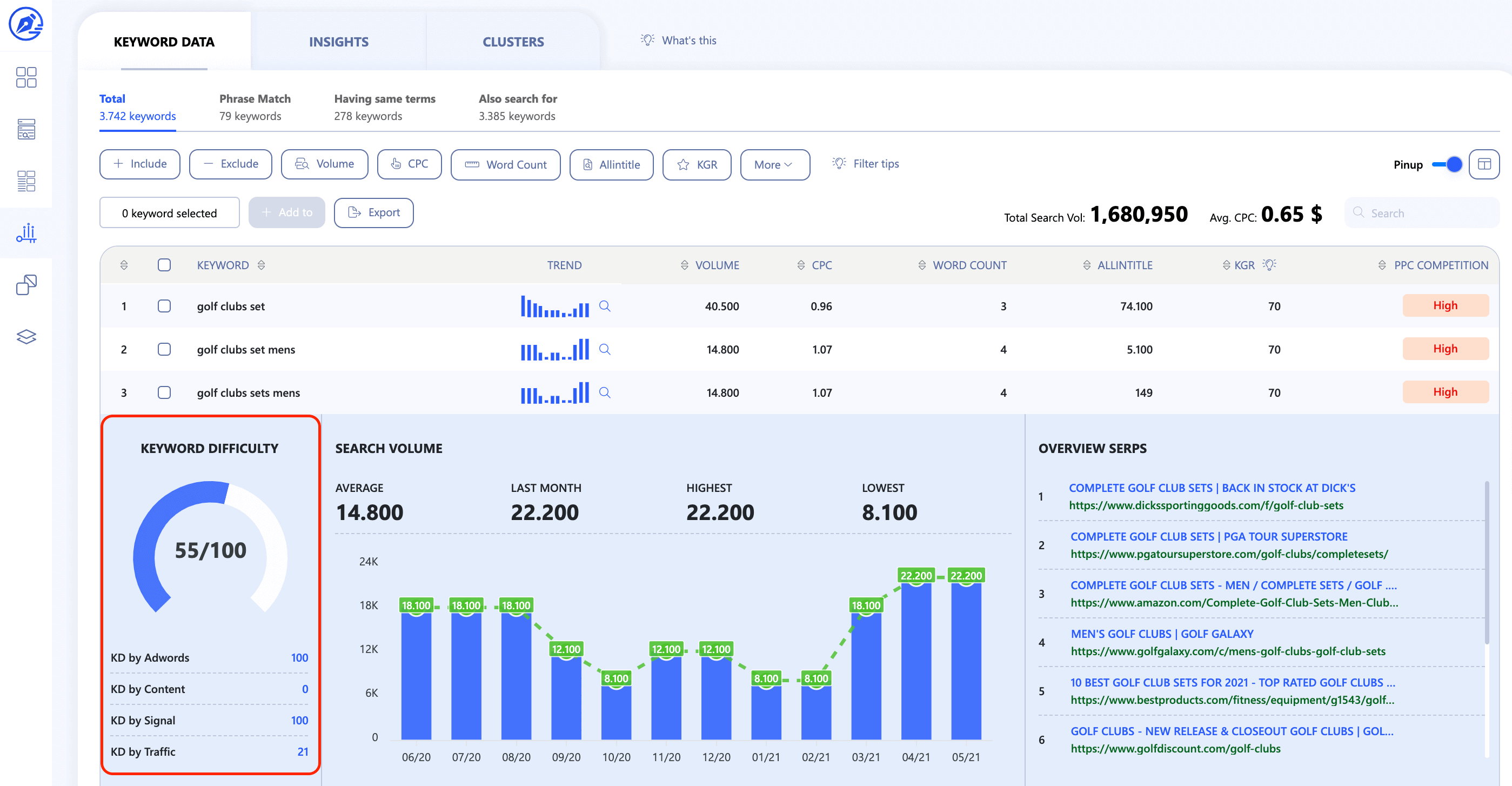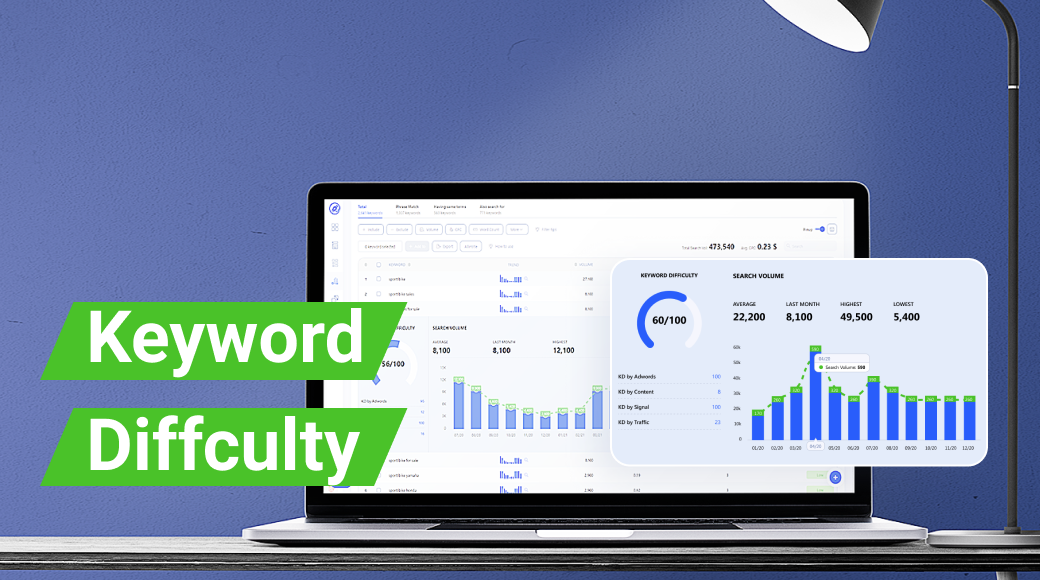Ha Tuan Khang | 10 mins read
The challenge
While implementing an SEO project, we always have to perform keyword research and select the appropriate keywords according to the capabilities, resources, and SEO strategy we choose. And determining how difficult a keyword is (Keyword difficulty) is very important. We have researched and analyzed this metric provided by many other parties such as Ahrefs and Semrush. But there is a prominent disadvantage in this regard - they only determine the difficulty of a keyword through the impact of the number of domains pointing to the domain that is ranking for a particular keyword. For some raters, the more referring domains there are on the top-ranking pages, the greater the keyword’s difficulty.
WriterZen's research team doesn't think so. The difficulty of a keyword is not only affected by each link effect (the more referring domains, the better the quality), but it also depends on many other factors.
Keyword difficulty algorithm in WriterZen

After analyzing, measuring, and experiencing many projects, we found that the difficulty of a keyword is also affected by other factors such as:
-
- The amount of content written about that keyword.
- The level of competition when running Google Ads.
- The number of mentions to the brand.
- The amount of traffic in the market directly affects the competition, or in other words, the difficulty of the keyword.
|
There are many examples to support our research. Some keywords have very low link difficulty, according to an analysis by Ahrefs or Semrush. But in reality, when implementing these keywords, we see that it is not as easy as we think based on the KD that Ahrefs gives. These are challenging keywords to compete with because there are too many parties writing articles about it (KD about content is very high), a lot of people are interested in it, leading to many parties investing in this keyword rank, which has very high traffic.
There is one thing that we, from newbies to SEO experts, all understand: implementing an SEO project with each person, each team, and each business has different strategies. Because each of us has various human factors, additional resources, and strengths. There are extreme parties in content, there are very strong parties with ample link resources, and there are parties with substantial traffic resources. We can't build the right SEO plan if we are strong in content but use KD on links to evaluate the difficulty of the project.

To be the right strategist, we have to analyze all the factors. We must then use our resources most reasonably. And believe us, we can sometimes be on top even though we are not strong in links, but strong in opposite factors. But to implement strategies to achieve this, we certainly need a KD metric that better reflects the keyword difficulty in all respects. That's why WriterZen took the risk to analyze and come up with a new way of determining KD, which is an amalgamation of evaluations based on content KD, mention KD, Google Ads KD, Link KD, and traffic KD. With this closer assessment, we'll give you the most accurate metrics about a keyword's competition.
Reminder: Keyword difficulty only measures your chances of getting into the top 10 of the SERP (not top 3 or top 1).
Keyword difficulty scale
WriterZen offers a keyword difficulty scale from 0 to 100. The higher the KD index, the higher the difficulty. And keyword difficulty evaluates on different factors such as content, mention, link, Google Ads CPC, or traffic that are not linear with each other.
1. Keyword Difficulty by Link
Here is the relationship between Keyword Difficulty by Link and the corresponding number of Referring Domains needed:
|
KD |
0-10 |
10-20 |
20-30 |
30-40 |
40-50 |
50-60 |
60-70 |
70-80 |
80-90 |
90-100 |
|
Referring domains (Needed) |
10 |
20 |
35 |
55 |
80 |
100 |
200 |
350 |
800 |
1000 |
|
Algorithm ( By KD-Metric of Ahref) |
||||||||||
2. Keyword Difficulty by Content
Below is the relationship between Keyword Difficulty by Content and the corresponding number of articles needed:
|
KD |
0-10 |
10-20 |
20-30 |
30-40 |
40-50 |
50-60 |
60-70 |
70-80 |
80-90 |
90-100 |
|
Algorithm (volume of a targeted keyword) |
10000 |
20000 |
40000 |
70000 |
100000 |
500000 |
1000000 |
2000000 |
5000000 |
10000000 |
The algorithm to determine Keyword Difficulty by Content is based on the total number of articles on all the websites in a particular country’s market about a keyword. Moreover, it is based on the analysis of 100 competitors on the SERP in terms of quantity and quality of content these competitors have. From there, we can get Keyword Difficulty by Content, based on which we have a basis for imagining the level of investment in content.
3. Keyword Difficulty by Mention (or Signal)
Below is the relationship between Keyword Difficulty by Mention (or Signal) and the corresponding amount of Mention needed:
|
KD |
0-10 |
10-20 |
20-30 |
30-40 |
40-50 |
50-60 |
60-70 |
70-80 |
80-90 |
90-100 |
|
Mention (Needed) |
10000 |
20000 |
40000 |
70000 |
100000 |
500000 |
1000000 |
2000000 |
5000000 |
10000000 |
Keyword Difficulty by Mention algorithm (reflecting the popularity of the brand associated with the website) is determined based on measuring the number of times users mention competitors' brands appearing on the SERP. The larger the number of mentions, the more competitive the keyword is. Our analysis is based on the measurement of 300 million websites. It makes a recommendation about the corresponding number of mentions needed to build to put the keyword in the top 10 under the influence of the mentioned factor to your brand.
4. Keyword Difficulty by Traffic
Below is the relationship between Keyword Difficulty by Traffic and the corresponding amount of Organic Traffic needed:
|
KD |
0-10 |
10-20 |
20-30 |
30-40 |
40-50 |
50-60 |
60-70 |
70-80 |
80-90 |
90-100 |
|
Organic Search (Needed) |
1000 |
2000 |
4000 |
7000 |
10000 |
50000 |
100000 |
200000 |
500000 |
1000000 |
|
Algorithm (volume of the targeted keyword) |
10000 |
20000 |
40000 |
70000 |
100000 |
500000 |
1000000 |
2000000 |
5000000 |
10000000 |
The algorithm to determine KD by traffic is based on determining the competition level and the amount of organic search traffic that needs to be built to rank in the top 10 with any keyword.
Conclusion

Analyzing and choosing the right keywords for the correct competition is a job that has never been simple. WriterZen, with a keyword difficulty determination mechanism based on many factors, will help you have the proper perspective and help you increase the likelihood of choosing keywords that bring you good traffic without requiring too much effort to rank. It will also help you make the most of the resources you have, either in terms of content, links, mentions, or traffic.
________________
Ha Tuan Khang
Co-founder of WriterZen









